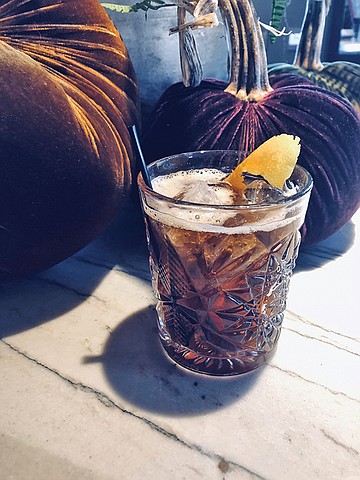 Facebook
Facebook
 X
X
 Instagram
Instagram
 TikTok
TikTok
 Youtube
Youtube

Citrus myrtaflora—more commonly known in its native Italy as the chinotto—is a diminutive member of the orange family, and it has a secret. But it’s one of the worst kinds of secret—one that everyone knows but don’t know that they know: anyone who’s coddled an amaro or puckered their whiskey or gin with a bit of Campari has had the chinotto (a major ingredient in both) in one distilled form or another. It’s also one of the lesser-known flavors of bubbly offered by San Pellegrino. And it was in this sweet form that the otherwise bitter and inedible chinotto caught the eye (and palate) of Samantha Hodgkins, bar manager of Amici’s Risto Bar.
According to Amici’s assistant bar manager Eric Knowlton, a can of San Pellegrino Chinotto was enough to convince Hodgkins that the fruit was bound for cocktail glory.
“The chinotto has a unique flavor,” he says. “It’s a little bitter and a little sweet, but well balanced.”
That sounds like an Old Fashioned. But, of course, when in Rome —or least at Amici’s—better make that a Fuori Moda. The actual name of Amici’s chinotto concoction, though, is much easier to remember than that: ask for The Chinotto.
“I guess you could call The Chinotto an Italian Old Fashioned,” Knowlton acknowledges, although in developing it, Hodgkins realized its foreign baggage needed some sorting out.
“She wanted to tie the chinotto flavor into a drink that didn’t require an acquired a taste for it,” Knowlton says. “That’s why we added the lemon to it, and a little of that orange twist, to give it a layer. And as bourbons go, the Four Roses naturally pairs with it too.”
But citrus myrtaflora never lets you forget it’s in charge of the whole affair.
“At first, the chinotto is there on the front, and it’s a little bitter, but is finishes smoother,” Knowlton says. “Then the lemon adds a layer between front and back. The bourbon isn’t too overpowering, and it complements well on the back end of the drink.”
Amici’s Chinotto

Add ingredients to a shaker (no ice), shake briefly, pour into rocks glass filled with ice, and garnish with orange twist.


Citrus myrtaflora—more commonly known in its native Italy as the chinotto—is a diminutive member of the orange family, and it has a secret. But it’s one of the worst kinds of secret—one that everyone knows but don’t know that they know: anyone who’s coddled an amaro or puckered their whiskey or gin with a bit of Campari has had the chinotto (a major ingredient in both) in one distilled form or another. It’s also one of the lesser-known flavors of bubbly offered by San Pellegrino. And it was in this sweet form that the otherwise bitter and inedible chinotto caught the eye (and palate) of Samantha Hodgkins, bar manager of Amici’s Risto Bar.
According to Amici’s assistant bar manager Eric Knowlton, a can of San Pellegrino Chinotto was enough to convince Hodgkins that the fruit was bound for cocktail glory.
“The chinotto has a unique flavor,” he says. “It’s a little bitter and a little sweet, but well balanced.”
That sounds like an Old Fashioned. But, of course, when in Rome —or least at Amici’s—better make that a Fuori Moda. The actual name of Amici’s chinotto concoction, though, is much easier to remember than that: ask for The Chinotto.
“I guess you could call The Chinotto an Italian Old Fashioned,” Knowlton acknowledges, although in developing it, Hodgkins realized its foreign baggage needed some sorting out.
“She wanted to tie the chinotto flavor into a drink that didn’t require an acquired a taste for it,” Knowlton says. “That’s why we added the lemon to it, and a little of that orange twist, to give it a layer. And as bourbons go, the Four Roses naturally pairs with it too.”
But citrus myrtaflora never lets you forget it’s in charge of the whole affair.
“At first, the chinotto is there on the front, and it’s a little bitter, but is finishes smoother,” Knowlton says. “Then the lemon adds a layer between front and back. The bourbon isn’t too overpowering, and it complements well on the back end of the drink.”
Amici’s Chinotto

Add ingredients to a shaker (no ice), shake briefly, pour into rocks glass filled with ice, and garnish with orange twist.
Comments